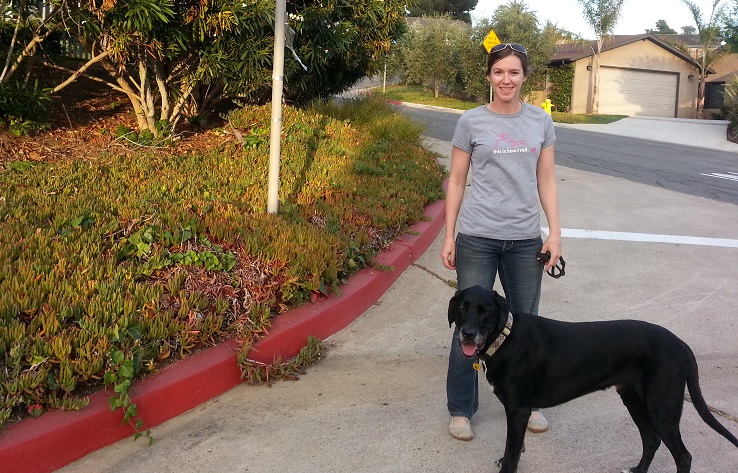When should pet sitters speak up about potential safety issues?
I started a pet sitting business in 2008, and since then I have helped hundreds of others start their own businesses through my ebook and consulting services.
In this post:
- – When should pet sitters speak up about potential safety issues in the pet’s day-to-day life?
- – How should the pet sitter bring it up?
One woman recently asked a really good question about when pet sitters should speak up about day-to-day things that could be causing the pet harm. For example, if the client’s dog is eating grapes off a vine in the yard, should you tell the client grapes are toxic to dogs? Or, should you let it go if the dog is not in immediate danger? And if you do bring it up, how should you go about it?
I’ll let you know what I think, and then I’d like to hear from the rest of you – whether you are a pet sitter or whether you are a pet owner in general. When would you want your pet sitter to say something?

When should pet sitters speak up about potential safety issues?
My opinion is that the pet sitter should always bring up any potential safety issues, no matter how minor. Then, the actual dog or cat owner can decided what to do with the information.
So if we use the example where the dog has been eating grapes, I would bring it up to the owner casually by saying something like, “I noticed Buddy tries to eat grapes in the back yard. Since grapes can be toxic to dogs, would you like me to keep him on a leash while in the yard?”
This gives the owner the opportunity to respond either way. She could say, “Oh, don’t worry about it. He eats them all the time, and he’s fine.” In that case, I would let it go unless the dog seems to be eating massive quantities of grapes. Or, she could say, “Oh, I didn’t know grapes were bad for dogs. Yes, please keep him on a leash.”
Obviously, this is quite different than accusing the person of being a bad pet owner. You are presenting her with the information and letting her decide what to do with that information. Except for a few rare cases, I trust the pet owner to be the best advocate for her own pet.
More serious issues – when should pet sitters speak up?
Of course, sometimes the issue will be a little more urgent.
For example, sometimes I care for dogs that live in the garage when their owners are out of town. Normally, keeping a dog in the garage is a non-issue, however there have been a few days where I believed it was going to be too hot for the dog. In those cases, I simply contacted the owners and said something like, “It’s going to be 95 degrees today. What would you like me to do to make sure Sam is OK?”
Again, this brings up the issue without attacking the dog owner or making him feel bad. It gives him the opportunity to come up with a solution, possibly letting the dog indoors during the middle of the day or taking the dog swimming.
In my experience, the owners have always seemed thankful for my concern. Then we work together to come up with the best solution.
If for some reason the pet owner is offended by your concern, it’s not personal. Perhaps that particular client is not the right match for you, and that’s OK. We are not all perfect for each other.
What if you can’t reach the pet’s owner?
Sooner or later, an issue might come up and the pet’s owner is unreachable. Perhaps she is camping somewhere without cell service, or maybe she is traveling on another continent. Maybe she’s just not answering her phone or checking email. In those cases, it’s up to you as the pet sitter to make the most appropriate decision for the pet.
In those cases, I try to put myself in the pet owner’s shoes and imagine what I would want someone to do for my own pet.
For example, maybe the owner has specifically asked you to leave the dog in the backyard during the day because she has severe separation anxiety when left in the house. However, on the third day, you notice the dog has started digging under the fence in an attempt to get out of the yard. If you can’t reach the dog’s owner, you would have to make the best decision for the dog based on what you know.
The best solution might be to start leaving the dog indoors in a crate. Or, maybe the best solution is to pile something heavy over the hole the dog has started digging. It’s all going to depend on the specific dog and the specific situation. How big is this dog? What do you have to work with? Does the dog even have a crate? Does the dog do OK in the house at night? Could you leave some Kong-type toys for the dog to work on?
Often, the best solution involves checking on the pet more often than you had originally scheduled. Maybe you visit the pet five times that day instead of three so you can provide more interaction and exercise. Or, maybe you stick with three visits, but you stay with the dog a little longer than usual.
So, what do the rest of you think?
If you’re a pet sitter, when do you bring up certain safety issues?
 Check back each Wednesday for posts related to starting your own dog walking, dog running or pet sitting business. For more information, check out my ebook on how to start a pet sitting business.
Check back each Wednesday for posts related to starting your own dog walking, dog running or pet sitting business. For more information, check out my ebook on how to start a pet sitting business.

Renchan Li
Tuesday 24th of September 2013
It is a precious thing to learn that those helping me are extending their experience to me. I would appreciate all comments and experience sharing from all dog services providers, including the sitters, and dog owners because the more I am informed, the better preparation I could have. I shall allow people to make the same mistakes twice for non-life-and-death issues.
Rebekah
Wednesday 18th of September 2013
I am guessing that most owners who employ the services of a pet sitter want what is best for their dogs, and would (hopefully) graciously accept any advice or concerns. I know I would. I would not hesitate to speak up, particularly if it is something that could potentially harm the dog.
Lindsay Stordahl
Wednesday 18th of September 2013
Yep, I think you about summed it up.
Elizabeth
Wednesday 18th of September 2013
I used to pet sit and at one of my regulars, I noticed that one of the cats was puking every day, and that it was reddish, which bothered me. My instructions were to bring the cats to the vet if I thought they were sick. I did, which was difficult. Sadly, because the owner was not there, they really couldn't run tests due to him being very scared and attacking. Sadly, this cat passed about 3 months later from stomach cancer.
The great thing was that the owners had left instructions for me to do what I saw fit. Even so far as one of the pets dieing while they were gone. Morbid, but thorough. It took some of the stress off the situation.
I like your ideas of being thoughtful and conversational about it. One dog I house sat only ate Bananas from her owner. Which are toxic to dogs. The owner and I had a good little giggle over it but the issue was addressed. I am sure Macy still gets a bite of banana when her owner is home, but at least she knows the risk. :-)
Sean
Friday 20th of September 2013
This comment proves why I think pet-sitters and dog-walkers have to be *extremely* careful about when they choose to say something, especially when it comes to food and diet.
Bananas are NOT toxic to dogs. (Some dogs may get an upset stomach from bananas, but that's true of many fruits and not remotely the same thing as toxicity.)
Sometimes, it's hard to remember the list of foods and keep in mind the difference between toxic and 'may not react well for certain dogs.' I know that every few months, I wind up getting stuck and needing to double-check (wait, avocados- good? bad? poison? heh)
So now with the bananas, you've told the owner something that isn't true and undermined your ability to point out actual safety hazards if this owner looks up the toxicity of bananas for dogs or brings it up with their vet and learns that you can't be trusted for accurate information.
If you want to say something to an owner, it's a lot better to provide them with resources (a link or print-out) and say, "I read that x may be toxic. Even though hasn't reacted, you might want to look into it or ask your vet..." than to declare something based on your recollection of what's dangerous.
Lindsay Stordahl
Wednesday 18th of September 2013
Good points about taking the pet to the vet. It's important to have this established ahead of time. I have all my clients sign a liability form that says I have permission to take the pets to the vet if I believe it's necessary, and that they will cover the expense.
I hadn't heard that bananas are toxic to dogs.